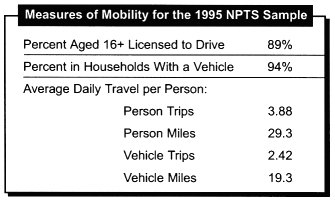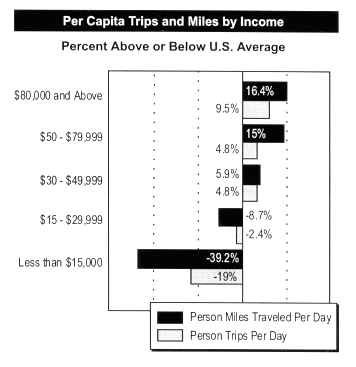U.S. Department of Transportation
Federal Highway Administration
1200 New Jersey Avenue, SE
Washington, DC 20590
202-366-4000
| |
| Conditions and Performance Report Executive Summary |
| Executive Summary Chapter Listing Conditions and Performance Home Page
|
|
Mobility links us to the economic, social and political benefits of our society. A transportation system that provides mobility is accessible, integrated and efficient and offers flexibility of choices. Our extensive intermodal transportation system helps make Americans one of the most mobile populations in the world. 
However, there are groups in our society that face significant mobility challenges. The Nationwide Personal Transportation Survey (NPTS) provides information so we can better understand how income, gender, age, and race impact mobility. While travel by single adults and adults without children does not vary by gender, travel by men and women with younger children is starkly different. In particular, working mothers make more trips and cover more miles than at any other time in the past three decades. Household income appears to be the single most significant determinant of mobility. All aspects of travel are related to income—the amount of travel, the area in which a person travels, and vehicle ownership. People in low-income households have fewer travel options and a much smaller radius of access to goods and services than those in higher income households. The high cost of acquiring, registering, insuring and maintaining a vehicle places vehicle ownership out of range for many low-income households. |
 Different mobility issues face the elderly because they typically drive less, live in more remote locations, and may require special services and facilities. Many of the poor elderly are single women, often minorities, who live alone. As our population ages, these issues will become more critical. Examining income in conjunction with race adds another dimension to the discussion of mobility. For example, even in the same income group, African-Americans take 15 percent fewer trips and travel almost a quarter less miles per person per day than whites. Although all elements of the population have increased their mobility over time, many challenges still exist. A transportation system that meets the mobility needs of all Americans must use both traditional and innovative approaches. |